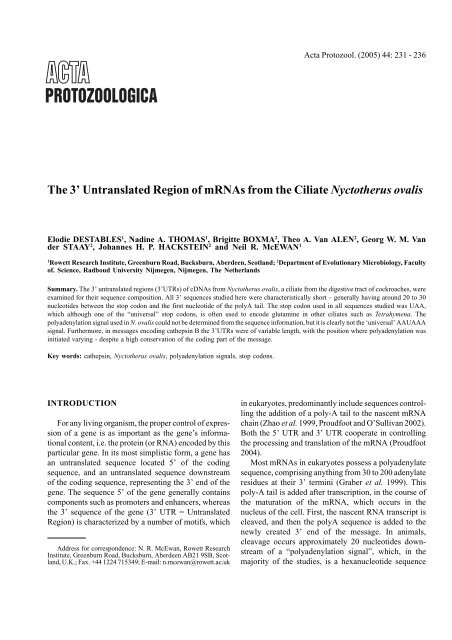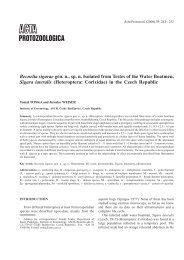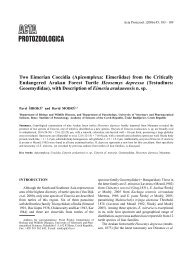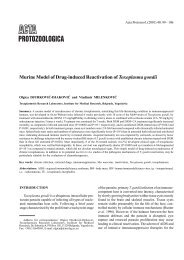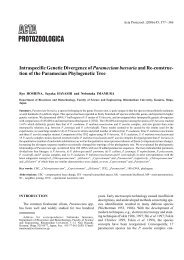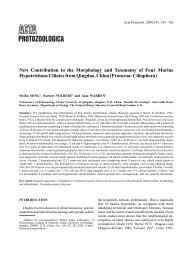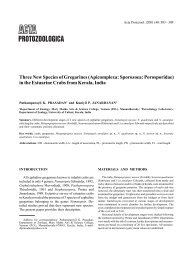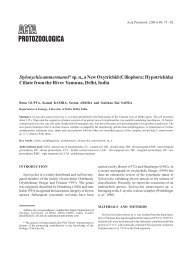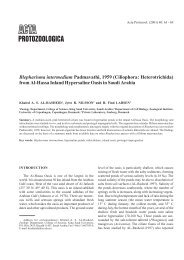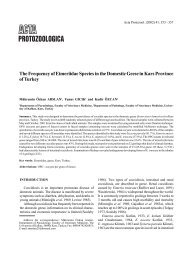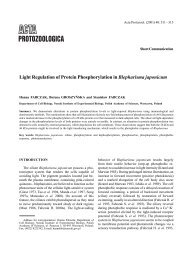Untranslated Region of mRNAs from the Ciliate ... - ResearchGate
Untranslated Region of mRNAs from the Ciliate ... - ResearchGate
Untranslated Region of mRNAs from the Ciliate ... - ResearchGate
Create successful ePaper yourself
Turn your PDF publications into a flip-book with our unique Google optimized e-Paper software.
Acta Protozool. (2005) 44: 231 - 236<br />
The 3’ <strong>Untranslated</strong> <strong>Region</strong> <strong>of</strong> <strong>mRNAs</strong> <strong>from</strong> <strong>the</strong> <strong>Ciliate</strong> Nycto<strong>the</strong>rus ovalis<br />
Elodie DESTABLES 1 , Nadine A. THOMAS 1 , Brigitte BOXMA 2 , Theo A. Van ALEN 2 , Georg W. M. Van<br />
der STAAY 2 , Johannes H. P. HACKSTEIN 2 and Neil R. McEWAN 1<br />
1<br />
Rowett Research Institute, Greenburn Road, Bucksburn, Aberdeen, Scotland; 2 Department <strong>of</strong> Evolutionary Microbiology, Faculty<br />
<strong>of</strong>. Science, Radboud University Nijmegen, Nijmegen, The Ne<strong>the</strong>rlands<br />
Summary. The 3’ untranslated regions (3’UTRs) <strong>of</strong> cDNAs <strong>from</strong> Nycto<strong>the</strong>rus ovalis, a ciliate <strong>from</strong> <strong>the</strong> digestive tract <strong>of</strong> cockroaches, were<br />
examined for <strong>the</strong>ir sequence composition. All 3’ sequences studied here were characteristically short – generally having around 20 to 30<br />
nucleotides between <strong>the</strong> stop codon and <strong>the</strong> first nucleotide <strong>of</strong> <strong>the</strong> polyA tail. The stop codon used in all sequences studied was UAA,<br />
which although one <strong>of</strong> <strong>the</strong> “universal” stop codons, is <strong>of</strong>ten used to encode glutamine in o<strong>the</strong>r ciliates such as Tetrahymena. The<br />
polyadenylation signal used in N. ovalis could not be determined <strong>from</strong> <strong>the</strong> sequence information, but it is clearly not <strong>the</strong> ‘universal’ AAUAAA<br />
signal. Fur<strong>the</strong>rmore, in messages encoding ca<strong>the</strong>psin B <strong>the</strong> 3’UTRs were <strong>of</strong> variable length, with <strong>the</strong> position where polyadenylation was<br />
initiated varying - despite a high conservation <strong>of</strong> <strong>the</strong> coding part <strong>of</strong> <strong>the</strong> message.<br />
Key words: ca<strong>the</strong>psin, Nycto<strong>the</strong>rus ovalis, polyadenylation signals, stop codons.<br />
INTRODUCTION<br />
For any living organism, <strong>the</strong> proper control <strong>of</strong> expression<br />
<strong>of</strong> a gene is as important as <strong>the</strong> gene’s informational<br />
content, i.e. <strong>the</strong> protein (or RNA) encoded by this<br />
particular gene. In its most simplistic form, a gene has<br />
an untranslated sequence located 5’ <strong>of</strong> <strong>the</strong> coding<br />
sequence, and an untranslated sequence downstream<br />
<strong>of</strong> <strong>the</strong> coding sequence, representing <strong>the</strong> 3’ end <strong>of</strong> <strong>the</strong><br />
gene. The sequence 5’ <strong>of</strong> <strong>the</strong> gene generally contains<br />
components such as promoters and enhancers, whereas<br />
<strong>the</strong> 3’ sequence <strong>of</strong> <strong>the</strong> gene (3’ UTR = <strong>Untranslated</strong><br />
<strong>Region</strong>) is characterized by a number <strong>of</strong> motifs, which<br />
Address for correspondence: N. R. McEwan, Rowett Research<br />
Institute, Greenburn Road, Bucksburn, Aberdeen AB21 9SB, Scotland,<br />
U.K.; Fax. +44 1224 715349; E-mail: n.mcewan@rowett.ac.uk<br />
in eukaryotes, predominantly include sequences controlling<br />
<strong>the</strong> addition <strong>of</strong> a poly-A tail to <strong>the</strong> nascent mRNA<br />
chain (Zhao et al. 1999, Proudfoot and O’Sullivan 2002).<br />
Both <strong>the</strong> 5’ UTR and 3’ UTR cooperate in controlling<br />
<strong>the</strong> processing and translation <strong>of</strong> <strong>the</strong> mRNA (Proudfoot<br />
2004).<br />
Most <strong>mRNAs</strong> in eukaryotes possess a polyadenylate<br />
sequence, comprising anything <strong>from</strong> 30 to 200 adenylate<br />
residues at <strong>the</strong>ir 3’ termini (Graber et al. 1999). This<br />
poly-A tail is added after transcription, in <strong>the</strong> course <strong>of</strong><br />
<strong>the</strong> maturation <strong>of</strong> <strong>the</strong> mRNA, which occurs in <strong>the</strong><br />
nucleus <strong>of</strong> <strong>the</strong> cell. First, <strong>the</strong> nascent RNA transcript is<br />
cleaved, and <strong>the</strong>n <strong>the</strong> polyA sequence is added to <strong>the</strong><br />
newly created 3’ end <strong>of</strong> <strong>the</strong> message. In animals,<br />
cleavage occurs approximately 20 nucleotides downstream<br />
<strong>of</strong> a “polyadenylation signal”, which, in <strong>the</strong><br />
majority <strong>of</strong> <strong>the</strong> studies, is a hexanucleotide sequence
232 E. Destables et al.<br />
(AAUAAA), which seemed to be highly conserved.<br />
Experimental studies revealed that a single substitution<br />
<strong>of</strong> any <strong>of</strong> <strong>the</strong>se six nucleotides led to a significant<br />
decrease in <strong>the</strong> efficiency <strong>of</strong> both polyadenylation and<br />
RNA cleavage (Sheets et al. 1990, Graber et al. 1999).<br />
Initially, <strong>the</strong> AAUAAA sequence (and its derivative<br />
AUUAAA - which can function at around 70% efficiency)<br />
was regarded as a universally conserved motif.<br />
More recently however, a number <strong>of</strong> studies have<br />
revealed that o<strong>the</strong>r eukaryotes make use <strong>of</strong> alternative<br />
polyadenylation motifs. Examples <strong>of</strong> organisms which<br />
use alternative motifs include yeast and plants, (Hyman<br />
et al. 1991, Rothnie 1996, Li and Hunt 1997, Graber<br />
2003). Moreover, <strong>the</strong>re can be a degree <strong>of</strong> flexibility<br />
which is not just restricted to sequence composition. For<br />
example <strong>the</strong>re can be variation in <strong>the</strong> polyadenylation<br />
site based on <strong>the</strong> carbon sources used in experiments<br />
with yeast (Sparks and Dieckmann 1998) or with <strong>the</strong><br />
cell-type (male germ cells) in mouse (MacDonald and<br />
Redondo 2002).<br />
In general, studies analysing polyadenylation in organisms<br />
o<strong>the</strong>r than man, mice, Drosophila, Saccharomyces<br />
cerevisiae, Arabidopsis thaliana, and Oryza sativa<br />
are sparce. In particular, <strong>the</strong>re is a remarkable lack<br />
<strong>of</strong> information about polyadenylation in protists, which<br />
represent a much greater biodiversity and divergence<br />
that animals, fungi and plants altoge<strong>the</strong>r. With respect to<br />
ciliates, which represent a particularly species-rich and<br />
very diverse taxon (Corliss 2004), only a few papers<br />
have been published dealing with <strong>the</strong> analysis <strong>of</strong><br />
polyadenylation <strong>of</strong> a few genes (Williams and Herrick<br />
1991, Liu and Gorovsky 1993, Ghosh et al. 1994, McEwan<br />
et al. 2000), and <strong>the</strong>se papers deal with sequence<br />
analysis for proposed polyadenylation ra<strong>the</strong>r than providing<br />
experimental evidence. In <strong>the</strong> rumen ciliate<br />
Entodinium caudatum (McEwan et al. 2000), it was<br />
concluded that <strong>the</strong> “universal” AAUAAA signal was<br />
absent, although a similar sequence, AUAAA was <strong>of</strong>ten<br />
present in <strong>the</strong> region where <strong>the</strong> polyadenylation signal<br />
would normally be found. Similarly, <strong>the</strong> “universal” signal<br />
was not found in cDNAs <strong>from</strong> Euplotes (Ghosh et al.<br />
1994), where <strong>the</strong> motif (A/U)UAAAA was proposed as<br />
a possible alternative polyadenylation signal. Limited<br />
sequence information led to <strong>the</strong> suggestion that Oxytricha<br />
fallax (Williams and Herrick 1991), uses three motifs-<br />
TAAAC, TGAAC and AGAAC, which might be described<br />
by <strong>the</strong> consensus sequence (tRAAC). In Tetrahymena<br />
<strong>the</strong>rmophila, <strong>the</strong> motifs TGTGT(N) TAA(N) 1-<br />
AAGTATT have been described in four<br />
8 0-11<br />
histone <strong>mRNAs</strong> (Liu and Gorovsky 1993). Moreover,<br />
<strong>the</strong> mating pheromone Er-1 in <strong>the</strong> ciliate Euplotes<br />
raikovi has been shown to have <strong>the</strong> unusual<br />
polyadenylation signal AACAAA (Miceli et al. 1992).<br />
Obviously, <strong>the</strong>se consensus motifs have little sequence<br />
identity in common with each o<strong>the</strong>r, or with <strong>the</strong> “universal”<br />
polyadenylation signal thought to be characteristic<br />
<strong>of</strong> animals.<br />
Here we describe a bioinformatical analysis <strong>of</strong> <strong>the</strong><br />
3’ untranslated regions (UTR) <strong>of</strong> a number <strong>of</strong><br />
cDNA sequences obtained by random sequencing <strong>of</strong> a<br />
cDNA library <strong>from</strong> <strong>the</strong> anaerobic ciliate Nycto<strong>the</strong>rus<br />
ovalis var. Blaberus sp. Amsterdam (Armophorea,<br />
Clevelandellida). This is an organism, which in keeping<br />
with o<strong>the</strong>r ciliate species, has two nuclei - a micronucleus<br />
(involved in sexual reproduction) and a macronucleus<br />
(involved in asexual reproduction). Within <strong>the</strong><br />
macronucleus chromosomes have been shown to exist<br />
as highly amplified gene-sized mini-chromosomes<br />
(Akhmanova et al. 1998). Thus, every gene is located on<br />
a short chromosome with telomeres at both ends, and<br />
<strong>the</strong>se genes function as a single transcription unit. Here<br />
we demonstrate that many, if not most, <strong>of</strong> <strong>the</strong>se genes<br />
lack <strong>the</strong> “universal” polyadenylation signals.<br />
MATERIALS AND METHODS<br />
Obtaining cDNA clones. Nycto<strong>the</strong>rus ovalis <strong>from</strong> strain Blaberus<br />
spec. Amsterdam thrives in <strong>the</strong> hindgut <strong>of</strong> <strong>the</strong> giant cockroach (Van<br />
Hoek et al. 1998), where it has been maintained in laboratory culture<br />
for more than 12 years. <strong>Ciliate</strong>s were harvested by electro-migration<br />
making use <strong>of</strong> <strong>the</strong>ir unique anodic galvanotactic swimming behaviour<br />
(Van Hoek et al. 1999). Immediately after isolation, <strong>the</strong> ciliates were<br />
lysed in 8 M guanidinium chloride. RNA was extracted with <strong>the</strong> aid <strong>of</strong><br />
<strong>the</strong> Rneasy Plant mini-kit (Qiagen) following <strong>the</strong> recommendatiosn <strong>of</strong><br />
<strong>the</strong> manufacturer. Total RNA was reverse transcribed, amplified, and<br />
<strong>the</strong> cDNA molecules cloned into pDNR-LIB (Clontech), and grown<br />
in E. coli strain DH5α by Genterprise, Mainz, Germany. Briefly, this<br />
was carried out as follows. The cDNA library was constructed using<br />
<strong>the</strong> “Creator SMART cDNA Library Construction” Kits <strong>from</strong><br />
BD Biosciences/Clontech. cDNA was amplified using <strong>the</strong> primers<br />
CDS III and SMART IV (CDS III: 5´- ATT CTA GAG GCC GAG<br />
GCG GCC GAC ATG d(T)30N_1N 3´; SMART IV 5´- AAG CAG<br />
TGG TAT CAA CGC AGA GTG GCC ATT ACG GCC GGG - 3´).<br />
After amplification, <strong>the</strong> cDNAs were size fractionated on Sepahryl<br />
S500 columns, and cloned into pDNR-LIB.<br />
DNA sequencing. 96 clones were picked at random and sequenced<br />
using <strong>the</strong> ABI Prism BigDye terminator sequencing ready<br />
reaction kit (Perkin Elmer Corporation, Norwalk, CT, USA) on an<br />
ABI Prism 377XL DNA sequencer (Perkin Elmer Corporation).<br />
Only sequences where a stop codon could be identified unequivocally<br />
(based on a combination <strong>of</strong> Blast analysis and translation in<br />
three different reading frames), were included into <strong>the</strong> study. Se-
Nycto<strong>the</strong>rus ovalis untranslated region <strong>of</strong> mRNA 233<br />
quences analysed fur<strong>the</strong>r in this study have been deposited in <strong>the</strong> EBI<br />
sequence database with accession numbers AJ965632-AJ965670.<br />
RESULTS AND DISCUSSION<br />
In <strong>the</strong> current dataset 39 cDNA sequences were<br />
recovered, which allowed <strong>the</strong> unequivocal identification<br />
<strong>of</strong> a stop codon. Of <strong>the</strong>se <strong>the</strong> 3’ UTR region <strong>of</strong> 25<br />
cDNAs were analysed initially, with 14 clones which<br />
encode ca<strong>the</strong>psin (cysteine protease) analysed separately<br />
in more detail (see below). Firstly, all <strong>of</strong> <strong>the</strong>se<br />
clones used TAA as a stop codon, as observed earlier<br />
(Akhmanova et al. 1998, Voncken et al. 2002, Van Hoek<br />
et al. unpublished). This supports <strong>the</strong> hypo<strong>the</strong>sis that<br />
N. ovalis uses a TAA or TAG to encode a stop codon<br />
(Knight et al. 2001, Lozupone et al. 2001), in contrast to<br />
o<strong>the</strong>r ciliates, which use TAA or TAG to encode glutamine<br />
(H<strong>of</strong>fman et al. 1995, Lozupone et al. 2001). The<br />
absence <strong>of</strong> codons for TGA, which is a stop codon but<br />
in Euplotes octocarinatus is <strong>the</strong> only codon for cysteine<br />
(Grimm et al. 1998) and has previously been discussed<br />
as having an unknown function in N. ovalis (Knight et<br />
al. 2001, Lozupone et al. 2001), may argue for N. ovalis<br />
using <strong>the</strong> universal genetic code.<br />
However, <strong>the</strong> sequences which have been studied<br />
previously for stop codon usage represent macronuclear<br />
genomic sequences. Hence it was unknown where <strong>the</strong><br />
polyadenylation site would lie within <strong>the</strong> messages transcribed<br />
<strong>from</strong> <strong>the</strong>se genes. What was clear <strong>from</strong> <strong>the</strong>se<br />
sequences is that <strong>the</strong> “universal” polyadenylation signals<br />
could not be identified. Consequently, it remained unclear<br />
how much <strong>of</strong> <strong>the</strong>se sequences is transcribed<br />
beyond <strong>the</strong> stop codon.<br />
The sequences studied here were recovered <strong>from</strong><br />
total RNA, and all are polyadenylated. Since, in addition,<br />
<strong>the</strong>y are likely to be derived <strong>from</strong> a macronuclear minichromosome<br />
suggesting that <strong>the</strong>y are likely to encode a<br />
functional gene. Fig. 1 shows, that <strong>the</strong> sequences between<br />
<strong>the</strong> stop codon and <strong>the</strong> poly-A tail are ra<strong>the</strong>r short<br />
for all <strong>of</strong> <strong>the</strong> cDNA sequences studied here. These<br />
sequences generally lack <strong>the</strong> motifs which have previously<br />
been described as polyadenylation signals in o<strong>the</strong>r<br />
organisms. Fur<strong>the</strong>rmore, <strong>the</strong>re is no obvious alternative<br />
motif common to <strong>the</strong> 3’ UTR <strong>of</strong> all <strong>of</strong> <strong>the</strong>se sequences.<br />
This conclusion is based on visual inspection, attempts to<br />
Fig 1. The sequence <strong>of</strong> <strong>the</strong> 3’ UTR <strong>of</strong> 25 randomly selected cDNA clones <strong>from</strong> <strong>the</strong> ciliate Nycto<strong>the</strong>rus ovalis.<br />
Sequence Nr Gene Encoded Stop codon 3’UTR Sequence<br />
255 Hypo<strong>the</strong>tical TAA TCTCTTAACACACAACGTTGAGTAAT<br />
257 Lactoylglutathione lyase TAA GTAATTCCTCACTCTCATTTCCATTCCATG<br />
259 Hypo<strong>the</strong>tical TAA CCGCTTCTAACCCTTAACCCACTTATTCAC<br />
260 Hypo<strong>the</strong>tical TAA CCATAATTCACAGTTCC<br />
261 Glutamate dehydrogenase TAA GCATACTAACCCATTCACTTATTGAC<br />
262 Beta/alpha-amylase TAA ATGATTTATTACCGTCTACTGAATTC<br />
277 Hypo<strong>the</strong>tical TAA TCTCTTAACACACAACGTTGAGTAAT<br />
279 Hypo<strong>the</strong>tical TAA CCCATCTAATCTATCACCACACCCTGCTTTACAAG<br />
284 Hypo<strong>the</strong>tical TAA TTCACCTGCGCCGCACCAGTATGTCTTCAC<br />
285 Ribosomal protein L32 TAA TCCCTGCCATCTCACGTACATATCACACCACATGC<br />
294 Hypo<strong>the</strong>tical TAA CGATTAACAATATCTTTGAC<br />
299 Hypo<strong>the</strong>tical TAA TCTCTTAACACACAACGTTGAGTAACCT<br />
303 Hypo<strong>the</strong>tical TAA CTGCCTAACCCTGACTAACTCACGTGCTCCG<br />
309 Ca<strong>the</strong>psin H TAA GCGACTAACGCTAACCTAACTTCTC<br />
312 Ribosomal protein L21 TAA GCTATTAACCTGCATACACCCAAGCATCCC<br />
321 Hypo<strong>the</strong>tical TAA AACCTTAATGGCTTAACTCACTTATTGATTTC<br />
324 Beta tubulin TAA GACTTTAACATTCACAAAACCTTTACG<br />
325 Hypo<strong>the</strong>tical TAA GCCCTTAACCCTCATTAATTAATCC<br />
335 Beta tubulin TAA GACTTTAACATTCACAAAACCTAG<br />
496 Hypo<strong>the</strong>tical TAA GCCCTTAACCCTGATTAATTAATGC<br />
503 Hypo<strong>the</strong>tical TAA ATTTCATTAACCCTCCGCTCACTCTTTCGATCC<br />
508 Hypo<strong>the</strong>tical TAA AACCTTAATGGCTTAACTCACTTATTGATTC<br />
556 Hypo<strong>the</strong>tical TAA GCTCTAACCCTCTCCTAATTAATTCAC<br />
557 Hypo<strong>the</strong>tical TAA AACCTTAATGGCTTAACTCACTTATTGATTCC<br />
586 Hypo<strong>the</strong>tical TAA CCGCTTCTAACCCTTAACCCACTTATTCGTG
234 E. Destables et al.<br />
Fig 2. Alignment <strong>of</strong> <strong>the</strong> DNA for 14 cDNA sequences <strong>from</strong> Nycto<strong>the</strong>rus ovalis. The stop codons are shown in bold and are underlined. Within <strong>the</strong> translated region <strong>of</strong> <strong>the</strong> gene only<br />
3 nucleotides are different across all <strong>of</strong> <strong>the</strong>se sequences. Two <strong>of</strong> <strong>the</strong>se gives synonymous amino acid substitutions, <strong>the</strong> o<strong>the</strong>r (blocked in grey) gives rise to an amino acid change.<br />
Positions <strong>of</strong> identity to <strong>the</strong> top sequence are indicated ‘.’. To maintain alignment <strong>of</strong> <strong>the</strong> first ‘A’ <strong>of</strong> <strong>the</strong> poly(A) tail and <strong>the</strong> last nucleotide which is not ‘A’, <strong>the</strong> areas with no nucleotide<br />
are shown ‘-‘.
Nycto<strong>the</strong>rus ovalis untranslated region <strong>of</strong> mRNA 235<br />
align sequences and searches carried out using <strong>the</strong><br />
UTResource database (http://bighost.area.ba.cnr.it/BIG/<br />
UTRHome).<br />
Notably, within <strong>the</strong> clones which were selected at<br />
random for sequencing were 14 which encoded a cysteine<br />
protease - ca<strong>the</strong>psin (Fig. 2). This number <strong>of</strong><br />
copies <strong>of</strong> this cDNA may at first appear ra<strong>the</strong>r high.<br />
However, due to <strong>the</strong> variability seen immediately prior to<br />
<strong>the</strong> polyadenylation site (discussed in more detail below)<br />
it appears unlikely that this is a reflection solely due to<br />
cDNA bank amplification. Fur<strong>the</strong>rmore, cysteine proteases<br />
are known to have a major role to play in ciliates<br />
(e.g. Parama et al. 2004), suggesting that <strong>the</strong>y may be<br />
represented as abundant messages.<br />
In <strong>the</strong> ca<strong>the</strong>psin cDNAs <strong>the</strong> sequence immediately<br />
prior to <strong>the</strong> stop codon was analysed to evaluate levels<br />
<strong>of</strong> variability within this region. This allowed analysis<br />
back 219 nucleotides (encoding 73 residues) prior to <strong>the</strong><br />
stop codon for each clone. In total, only 6 nucleotide<br />
substitutions were detected - 4 <strong>of</strong> which were identical<br />
(i.e. 6 <strong>from</strong> 3066 nucleotides) and with one exception<br />
<strong>the</strong>se encoded synonymous substitutions - with <strong>the</strong> four<br />
identical substitutions occurring in <strong>the</strong> codon immediately<br />
prior to <strong>the</strong> stop codon. This level <strong>of</strong> sequence conservation<br />
is also observed in <strong>the</strong> first 28 nucleotides following<br />
<strong>the</strong> stop codon, with only one cDNA having a single<br />
nucleotide deviation <strong>from</strong> <strong>the</strong> o<strong>the</strong>rs. However, in <strong>the</strong><br />
subsequent nucleotides, which precede <strong>the</strong> polyA tail -<br />
ranging in length <strong>from</strong> 2 to 6 nucleotides - <strong>the</strong>re are 12<br />
unique sequences within <strong>the</strong> 14 clones (clones 330 and<br />
337 are identical to each o<strong>the</strong>r, as are clones 271 and<br />
328). This is a high level <strong>of</strong> variability, both in terms <strong>of</strong><br />
sequence length and sequence content, and is unprecedented<br />
in <strong>the</strong> sequence prior to <strong>the</strong> stop codon.<br />
The reason for this variability immediately prior to <strong>the</strong><br />
polyadenylation site is unknown. A number <strong>of</strong> different<br />
mechanisms may be proposed as <strong>the</strong> answer to this<br />
dilemma, but <strong>the</strong>re are probably three most likely causes:<br />
(1) it may be due to non-specific addition <strong>of</strong> nucleotides<br />
to <strong>the</strong> nascent message prior to polyadenylation; (2) <strong>the</strong><br />
polymorphisms may have arisen in <strong>the</strong> DNA as a<br />
consequence <strong>of</strong> re-arrangements during <strong>the</strong> formation <strong>of</strong><br />
macronuclear mini-chromosomes; or (3) a number <strong>of</strong><br />
different copies <strong>of</strong> <strong>the</strong> gene exist within <strong>the</strong> micronucleus<br />
- effectively different paralogues which still<br />
share <strong>the</strong> same function due to conservation within <strong>the</strong><br />
coding region. It is unclear which <strong>of</strong> <strong>the</strong>se mechanisms<br />
is taking place, and <strong>the</strong>y should not be considered as<br />
being mutually exclusive, with more than one <strong>of</strong> <strong>the</strong>se<br />
factors being possible.<br />
However, it is interesting to note that in a study which<br />
included analysis <strong>of</strong> different cDNAs <strong>from</strong> messages for<br />
actin genes (Ghosh et al. 1994) a similar observation<br />
was made whereby <strong>the</strong> actin messages were<br />
polyadenylated at one <strong>of</strong> two different sites. The authors<br />
point out that it is unclear if <strong>the</strong> two forms <strong>of</strong> messages<br />
co-exist in a cell, or if <strong>the</strong>y are used in a developmentalspecific<br />
manner. The range in number <strong>of</strong> different<br />
messages identified here, although not precluding developmental-specific<br />
versions <strong>of</strong> <strong>the</strong> message, would appear<br />
to argue against <strong>the</strong>re only being a single form <strong>of</strong><br />
<strong>the</strong> message present in different developmental stages.<br />
Thus, it has to be concluded <strong>from</strong> <strong>the</strong> genes analysed<br />
here that: (i) Nycto<strong>the</strong>rus ovalis does not make use <strong>of</strong><br />
any <strong>of</strong> <strong>the</strong> “universal” polyadenylation signals, or <strong>of</strong><br />
putative polyadenylation signals which have been described<br />
previously; (ii) that <strong>the</strong>re is no evidence for any<br />
obvious candidate sequence to signal <strong>the</strong> onset <strong>of</strong><br />
polyadenylation; and (iii) that, at least in <strong>the</strong> case <strong>of</strong> <strong>the</strong><br />
ca<strong>the</strong>psin cDNA clones, <strong>the</strong> precise initiation site for<br />
polyadenylation is also not clearly determined, since this<br />
region exhibits a hyper-variability in <strong>the</strong> region 29-34<br />
nucleotides following <strong>the</strong> stop codon - both in terms <strong>of</strong><br />
sequence length and composition.<br />
Acknowledgements. This work was performed as part <strong>of</strong> <strong>the</strong> EU<br />
Framework V Quality <strong>of</strong> Life and Management <strong>of</strong> Living Resources<br />
Research Programme grant CIMES (QLK3-2002-02151). The Rowett<br />
Research Institute receives funding <strong>from</strong> SEERAD.<br />
REFERENCES<br />
Akhmanova A., Voncken F., Van Alen T., Van Hoek A., Boxma B.,<br />
Vogels G., Veenhuis M., Hackstein J. H. P. (1998) A<br />
hydrogenosome with a genome. Nature 396: 527-528<br />
Corliss J. O. (2004) Why <strong>the</strong> world needs protists! J. Euk. Microbiol.<br />
51: 8-22<br />
Ghosh S., Jaraczewski J. W., Klobutcher L. A., Jahn C. L. (1994)<br />
Characterization <strong>of</strong> transcription initiation, translation initiation,<br />
and poly(A) addition sites in <strong>the</strong> gene-sized macronuclear DNA<br />
molecules <strong>of</strong> Euplotes. Nucleic Acids Res. 22: 214-221<br />
Graber J. H. (2003) Variations in yeast 3'-processing cis-elements<br />
correlate with transcript stability. Trends Genet. 19: 473-476<br />
Graber J. H., Cantor C. R., Mohr S. C., Smith T. F. (1999) In silico<br />
detection <strong>of</strong> control signals: mRNA 3'-end-processing sequences<br />
in diverse species. Proc. Natl. Acad. Sci. USA 96: 14055-14060<br />
Grimm M., Brunen-Nieweler C., Junker V., Heckmann K., Beier H.<br />
(1998) The hypotrichous ciliate Euplotes octocarinatus has only<br />
one type <strong>of</strong> tRNA Cys with GCA anticodon encoded on a single<br />
macronuclear DNA molecule. Nucleic Acids Res. 26: 4557-4565<br />
H<strong>of</strong>fman D. C., Anderson R. C., DuBois M. L., Prescott D. M.<br />
(1995) Macronuclear gene-sized molecules <strong>of</strong> hypotrichs. Nucleic<br />
Acids Res. 23: 1279-1283
236 E. Destables et al.<br />
Hyman L. E., Seiler S. H., Whoriskey J., Moore C. L. (1991) Point<br />
mutations upstream <strong>of</strong> <strong>the</strong> yeast ADH2 poly(A) site significantly<br />
reduce <strong>the</strong> efficiency <strong>of</strong> <strong>the</strong> 3’-end formation. Mol. Cellular Biol.<br />
11: 2004-2012<br />
Knight R. D, Freeland S. J., Landweber L. F. (2001) Rewiring <strong>the</strong><br />
keyboard: evolvability <strong>of</strong> <strong>the</strong> genetic code. Nat. Rev. Genet. 2: 49-<br />
58<br />
Li Q., Hunt A. G. (1997) The polyadenylation <strong>of</strong> RNA in plants.<br />
Plant Physiol. 115: 321-325<br />
Lozupone C. A., Knight R. D., Landweber L.F. (2001) The molecular<br />
basis <strong>of</strong> nuclear genetic code change in ciliates. Curr. Biol. 11: 65-<br />
74<br />
Liu X., Gorovsky M. A. (1993) Mapping <strong>the</strong> 5’ and 3’ ends <strong>of</strong><br />
Tetrahymena <strong>the</strong>rmophila <strong>mRNAs</strong> using RNA ligase mediated<br />
amplification <strong>of</strong> cDNA ends (RLM-RACE). Nucleic Acids Res.<br />
21: 4954-4960<br />
MacDonald C.C., Redondo J.L. (2001) Reexamining <strong>the</strong><br />
polyadenylation signal: were we wrong about AAUAAA? Mol.<br />
Cell Endocrinol. 90: 1-8<br />
McEwan N. R., Eschenlauer S. C. P., Calza R .E., Wallace R. J.,<br />
Newbold C. J. (2000) The 3' untranslated region <strong>of</strong> messages in<br />
<strong>the</strong> rumen protozoan Entodinium caudatum. Protist 151: 139-<br />
146<br />
Miceli C., La Terza A., Bradshaw R. A., Luporini P. (1992) Identification<br />
and structural characterization <strong>of</strong> a cDNA clone encoding<br />
a membrane-bound form <strong>of</strong> <strong>the</strong> polypeptide pheromone Er-1 in<br />
<strong>the</strong> ciliate protozoan Euplotes raikovi. Proc. Natl. Acad. Sci USA.<br />
89: 1988-1992<br />
Parama A., Iglesias R., Alvarez M. F., Leiro J., Ubeira F. M.,<br />
Sanmartin M. L. (2004) Cysteine proteinase activities in <strong>the</strong> fish<br />
pathogen Philasterides dicentrarchi (Ciliophora: Scuticociliatida).<br />
Parasitology 128: 541-548<br />
Proudfoot N. (2004) New perspectives on connecting messenger<br />
RNA 3' end formation to transcription. Curr. Opin. Cell. Biol.<br />
16: 272-278<br />
Proudfoot N., O’Sullivan J. (2002) Polyadenylation: a tail <strong>of</strong> two<br />
complexes. Curr. Biol. 12: R855-R857<br />
Rothnie H. M. (1996) Plant mRNA 3'-end formation. Plant Mol. Biol.<br />
32: 43-61<br />
Sheets M. D, Ogg S. C., Wickens M. P. (1990) Point mutations in<br />
AAUAAA and <strong>the</strong> poly(A) addition site: effects on <strong>the</strong> accuracy<br />
and efficiency <strong>of</strong> cleavage and polyadenylation in vitro. Nucleic<br />
Acids Res. 18: 5799-5805<br />
Sparks K. A., Dieckmann C. L. (1998) Regulation <strong>of</strong> poly(A) site<br />
chice <strong>of</strong> several yeast <strong>mRNAs</strong>. Nucleic Acids Res. 20: 4676-4687<br />
Van Hoek A. H., van Alen T. A., Sprakel V. S., Hackstein J. H. P.,<br />
Vogels G. D. (1998) Evolution <strong>of</strong> anaerobic ciliates <strong>from</strong> <strong>the</strong><br />
gastrointestinal tract: phylogenetic analysis <strong>of</strong> <strong>the</strong> ribosomal<br />
repeat <strong>from</strong> Nycto<strong>the</strong>rus ovalis and its relatives. Mol. Biol. Evol.<br />
15: 1195-1206<br />
Van Hoek A. H., Sprakel V. S., Van Alen T. A., Theuvenet A. P., Vogels<br />
G. D., Hackstein J. H. P. (1999) Voltage-dependent reversal <strong>of</strong><br />
anodic galvanotaxis in Nycto<strong>the</strong>rus ovalis. J. Euk. Microbiol. 46:<br />
427-433<br />
Voncken F., Boxma B., Tjaden J., Akhmanova A., Huynen M.,<br />
Verbeek F., Tielens A.G., Haferkamp I., Neuhaus H. E., Vogels G.,<br />
Veenhuis M., Hackstein J. H. P. (2002) Multiple origins <strong>of</strong><br />
hydrogenosomes: functional and phylogenetic evidence <strong>from</strong> <strong>the</strong><br />
ADP/ATP carrier <strong>of</strong> <strong>the</strong> anaerobic chytrid Neocallimastix sp.<br />
Mol. Microbiol. 44: 1441-1454<br />
Williams K.R., Herrick G. (1991) Expression <strong>of</strong> <strong>the</strong> gene encoded by<br />
a family <strong>of</strong> macronuclear chromosomes generated by alternative<br />
DNA processing in Oxytricha fallax. Nucleic Acids Res. 19: 4717-<br />
4724<br />
Zhao J., Hyman L., Moore C. (1999) Formation <strong>of</strong> mRNA 3' ends<br />
in eukaryotes: mechanism, regulation, and interrelationships with<br />
o<strong>the</strong>r steps in mRNA syn<strong>the</strong>sis. Microbiol. Mol. Biol. Rev. 63:<br />
405-45<br />
Received on 21st February, 2005; revised version on 6th May, 2005;<br />
accepted on 12th May, 2005


